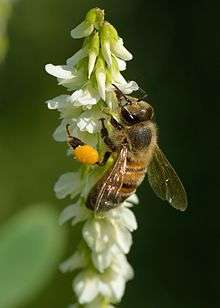Bee pollen


Bee pollen is the pollen ball that has been packed by worker honeybees into pellets. Bee bread is also the bee pollen with added honey and bee secretions and stored in brood cells,[1] chambers of honeybees or of wood and mud created by female ground-nesting (such as the Leafcutting Bee) bees.[2] With the Leafcutting Bee, when the pollen ball is complete, a single female lays an egg on top of the pollen ball, and seals the brood cell.[3] Pollen balls are harvested as food for humans. Bee pollen is sometimes referred to as ambrosia.[4] Where as with Honeybees, the thing to keep in mind is that the forager bees that gather pollen do not eat it themselves, since when they transition to foraging, they stop producing the proteolytic enzymes necessary to digest it. So the foragers unload the pollen they’ve gathered directly into open cells located at the interface between the brood and stored honey, creating a typical band of what is called beebread - the substance which is the main food source for honey bee larvae and workers.
Foraging bees bring pollen back to the hive, where they pass it off to other worker bees, who pack the pollen into cells with their heads. During collection and possibly packing, the pollen is mixed with nectar and bee salivary secretions. Bee pollen is the primary source of protein for the hive.[5] This method of packing can be seen in the bee species Xylocopa sulcatipes[6] and Xylocopa varipuncta.
Composition
Like honey and propolis, other well-known honey bee products that are gathered rather than secreted (i.e., in contrast to royal jelly and beeswax), the exact chemical composition depends on the plants the worker bees gather the pollen from, and can vary from hour to hour, day to day, week to week, colony to colony, even in the same apiary, with no two samples of bee pollen exactly identical. Accordingly, chemical and nutritional analyses of bee pollen apply only to the specific samples being tested, and cannot be extrapolated to samples gathered in other places or other times. Although there is no specific chemical composition, the average composition is said to be 40-60% simple sugars (fructose and glucose), 2-60% proteins, 3% minerals and vitamins, 1-32% fatty acids, and 5% diverse other components.[7] A study of bee pollen samples showed that they may contain 188 kinds of fungi and 29 kinds of bacteria.[8] Despite this microbial diversity, stored pollen (also called bee bread) is a preservation environment similar to honey, and contains consistently low microbial biomass.[9]
Use as a health supplement
Bee pollen has been touted by herbalists as a treatment for a variety of medical conditions[10] but there is no scientific evidence to show that it has any health benefits.[11] Bee pollen is safe for short term use, but for those with pollen allergies, allergic reactions may occur (shortness of breath, hives, swelling, and anaphylaxis).[11] Bee pollen is not safe for pregnant women and should not be used during breastfeeding.[11] The Food and Drug Administration has warned against the use of some bee pollen products because they are adulterated with unapproved drugs including sibutramine and phenolphthalein.[12][13]
References

- ↑ Stefan Bogdanov, Pollen: Production, Nutrition and Health: A Review, Bee Product Science, 2014, p. 3
- ↑ "Examination of "pollen Balls" in the Nests of the Alfalfa Leafcutting Bee, Megachile Rotundata". United States Department of Agriculture. Agricultural Research Service. Retrieved 10 September 2011.
- ↑ Thorp, Robbin W. "Vernal pool flowers and their specialist bee pollinators". California Vernal Pools. Retrieved 11 September 2011.
- ↑ Oxford Canadian Dictionary
- ↑ Sammataro, Diana and Avitabile, Alphonse. (2011) The Beekeeper's Handbook. Cornell University Press. ISBN 0-8014-7694-1
- ↑ Gerling, Dan; Hurd, Paul David; Hefetz, Abraham (1983). Comparative behavioral biology of two Middle East species of carpenter bees (Xylocopa Latreille)(Hymenoptera: Apoidea). Smithsonian Contributions to Zoology. Smithsonian Institution Press.
- ↑ "What Is Bee Bread?". Keeping-honey-bees.com. September 2011. Retrieved October 5, 2011.
- ↑ Black, Jacquelyn G. (2004). Microbiology. John Wiley and Sons. ISBN 0-471-42084-0.
- ↑ Kirk E. Anderson et al. 2014 Hive-stored pollen of honey bees: many lines of evidence are consistent with pollen preservation, not nutrient conversion. Molecular Ecology 23:23 url= http://onlinelibrary.wiley.com/doi/10.1111/mec.12966/abstract
- ↑ Yang, Kai; Wu, Dan; Ye, Xingqian; Liu, Donghong; Chen, Jianchu; Sun, Peilong (2013-01-23). "Characterization of Chemical Composition of Bee Pollen in China". Journal of Agricultural and Food Chemistry. 61 (3): 708–718. doi:10.1021/jf304056b. ISSN 0021-8561.
- 1 2 3 "Bee Pollen Benefits and Side Effects". WebMD. Retrieved April 16, 2014.
after years of research, scientists still cannot confirm that bee pollen has any health benefits", "medical research has not shown that bee pollen is effective for any of these health concerns
- ↑ "Public Notification: "Zi Xiu Tang Bee Pollen Capsules" Contains Hidden Drug Ingredient". Food and Drug Administration. October 24, 2012. Retrieved April 16, 2014.
- ↑ "FDA warns consumers not to use Zi Xiu Tang Bee Pollen capsules". Food and Drug Administration. April 7, 2014. Retrieved April 16, 2014.
External links
| Wikimedia Commons has media related to Bee pollen. |
- Producing Pollen
- Xylocopa varipuncta (Example bee)